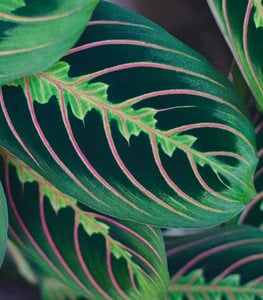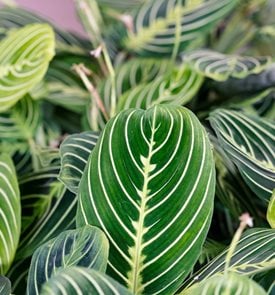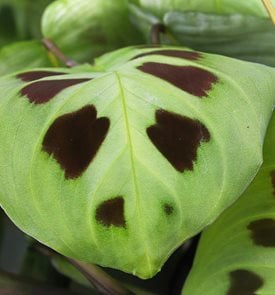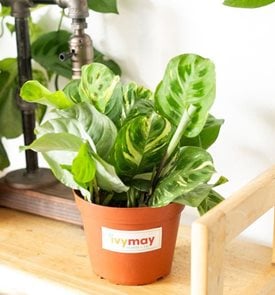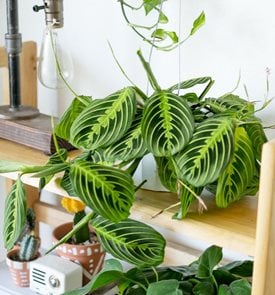A Guide to Growing Prayer Plants
Grow maranta plants with dazzling leaf colors and patterns.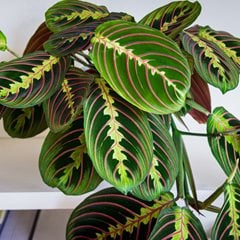
Red prayer plant. Photo by: Maritxu / Shutterstock
Prayer plant is named for the light-sensitive leaves that lay flat during the day, folding upright like praying hands at night. This popular houseplant is a tropical evergreen perennial grown for the foliage, which comes in an array of colors and patterns.
This easy-to-grow plant is slow growing and stays relatively small, making it ideal for small apartments and other limited spaces. Plants can be kept bushy or allowed to trail, and are suitable for display in decorative pots or hanging baskets. Learn how to grow and care for this intriguing houseplant.
On this page: Basics | Growing | Care | Varieties | Troubleshooting | Display Ideas
On this page:
- BASICS
- GROWING PRAYER PLANTS
- PRAYER PLANT CARE
- PRAYER PLANT VARIETIES
- COMMON PROBLEMS
- DISPLAY IDEAS FOR PRAYER PLANTS
PRAYER PLANT BASICS
Botanical name:
Maranta spp.
Common names:
Prayer plant, cathedral windows, herringbone plant
Origin:
Native to tropical rainforests of Central America, South America and West Indies
Care level:
Easy to moderate
Size:
6 to 12 inches tall and wide, trailing to 18 inches
Growth rate:
Slow
Foliage:
Wide oval-shaped leaves 4 to 8 inches long have distinct stripes or markings. The base coloring occurs in varying shades of green, blue-green, or yellow-green. Veining can be red, cream, or contrasting green. Markings are purple, brown, or green, while leaf undersides occur in green or burgundy. New leaves emerge in a tightly rolled tube.
Flowers:
Small white or purple orchid-like flowers appear in spring. Flowers are insignificant, and plants do not always bloom indoors.
Are prayer plants plants toxic?
Prayer plant is non-toxic to pets and children, though mild stomach upset can occur when any plant is ingested.
Prayer plant lookalikes—Maranta vs. Calathea:
These two genera look similar and share the common name of prayer plant, so are sometimes confused or mislabeled. Though both are in the Marantaceae family, the arrowroot family, there are differences. Maranta leaves are consistently oval-shaped, while Calathea comes in different leaf shapes. Calathea coloring and leaf patterns are more variable and often more pronounced. Maranta develops a trailing habit, while Calathea remains upright.
GROWING PRAYER PLANTS
Light:
Place near a window that gets bright indirect sunlight. Avoid direct sunlight, which can cause leaf burn.
Temperature:
Prayer plant prefers warmer temperatures, with an optimal range between 65-85 degrees F.
Humidity:
Native to moist rainforests, prayer plant prefers moderate to high humidity. To increase humidity, use a room humidifier, mist plants regularly, or set plants on a shallow tray filled with pebbles and water. Don’t allow the bottom of the pot to sit in standing water to prevent root rot.
Soil:
Use a high-quality, all-purpose potting mix that drains well. Maranta plants prefer a slightly acidic pH of 5.5 to 6.0; higher pH may cause chlorosis (yellowing of leaves).
Pot requirements:
Prayer plant has shallow roots, so a pot that is somewhat shallow and wide is more suitable than one that is tall and deep. Plant in a pot with adequate drainage holes that is slightly larger than the root ball.
PRAYER PLANT CARE
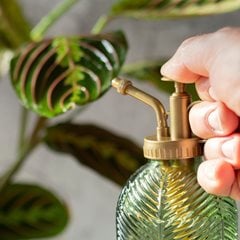
Photo by: Rigsbyphoto / Shutterstock
Watering:
Keep soil evenly moist, as prayer plants don’t like to dry out. Water when the top 1 to 2 inches of soil feels dry to the touch. Avoid overwatering to prevent root rot. Reduce watering during winter months when plants enter a period of semi-dormancy.
TIP: Maranta plants may be sensitive to hard tap water. Use filtered water or leave tap water out overnight before using. Prayer plants also prefer water that is at room temperature.
Fertilizing:
Apply a balanced water-soluble fertilizer every two weeks during the growing season from spring through fall. Cease fertilizing in winter when plant growth slows down.
Pruning:
Plants can be kept bushy or allowed to trail. Prune your prayer plant to desired size in spring by clipping just above a leaf node. Remove dead or damaged leaves as needed.
Leaf care:
Keep the foliage nice and shiny by cleaning it occasionally with a damp cloth. This is also a good opportunity to check for pests that may be hiding under the large leaves.
Repotting:
Prayer plants grow slowly, so only need to be repotted every 2 to 3 years. The best time to repot is in spring or summer. Choose a pot that is 2 inches larger than the previous pot. Remove plant from pot, shake off excess soil from roots and repot in fresh soil.
Pests:
The most common pests are spider mites, aphids, thrips, and mealybugs. Determine what kind of bugs are on your plant by examining closely. Remove pests with a cotton ball dipped in 70% rubbing alcohol. For persistent infestations, use insecticidal soap or Neem oil and reapply as needed. Isolate affected plants until pests are eliminated. (See more on common houseplant pests.)
PRAYER PLANT VARIETIES
COMMON PROBLEMS WITH PRAYER PLANTS
Most problems are due to incorrect care. Look for these symptoms:
- Scorched or faded leaves can be a sign of too much light. Move to a spot that receives less light.
- Brown leaf tips can be due to several factors, including cool temperatures, lack of humidity, or too much chlorine in tap water. Identify the problem and remedy accordingly.
- Yellow leaves can be caused by a number of reasons, including improper light or watering, chlorosis (an iron deficiency), over-fertilizing or root rot. Older leaves will turn yellow and die naturally. Diagnose and treat as needed.
- Curling or shriveled leaves are caused by a lack of water or low humidity. Increase watering or raise room humidity as needed.
- Drooping leaves can be due to a number of factors, including poor watering, extreme temperatures, too much light, low humidity, bug infestations, or over-fertilization. Identify the problem and correct accordingly.
- Poor leaf coloring can be an indication of too much or too little light, as well as nutritional deficiency such as chlorosis.
- Stunted growth can be due to root rot, nutritional deficiency, or improper soil pH, which can affect a plant’s ability to absorb nutrients. Diagnose and treat accordingly.
- Brown coloring around the base is a symptom of root rot. Remove plant from pot and inspect roots. Prune out any roots that are brown and mushy. Repot and reduce watering.
- Leaf drop can be caused by pest infestations or underwatering. Diagnose and treat accordingly.
DISPLAY IDEAS FOR PRAYER PLANTS
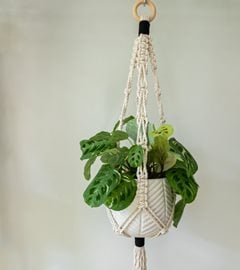
Photo by: TippyTortue / Shutterstock
There are many ways to display prayer plant; here are just a few:
- Group different varieties together on a dining room or board room tabletop for year-round color.
- Adorn a kitchen counter or windowsill with a single specimen or grouping of plants.
- Allow to trail in a hanging basket in a bathroom where plants can benefit from extra room humidity.
- Display in a decorative macrame hanger in a smaller room where space is at a premium.
- Adorn a desktop with a brightly colored specimen to cheer up an office environment.
- In frost-free climates or interior landscapes, prayer plant can be massed as a groundcover.
RELATED:
21 Best Indoor Plants
A Guide to Growing Peace Lily
A Guide to Growing Pothos
